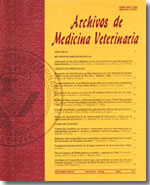Effect of three different sources of phosphorous in the feed of Broiler chicks on the productive yield
Main Article Content
Abstract
The biological value of three phosphate feeds and the tissue concentration of some potentially toxic elements were assessed using two raw rock tricalcium phosphates (RRPA and RRPC ), a dicalcium dehydrated phosphate (DPB) and two levels of available P (0.40 and 0.45%), in a 3x2 factorial arrangement of treatments, with one to twenty-one day old broiler chicks.
There were no interactions (p > 0.05) for the variables measured. DPB was associated, without statistical significance, with faster growth rate and better feed conversion efficiency. DPB had also the highest biological value of the three phosphates. It also presented the highest (p < 0.05) tibia ash and the greatest (p < 0.05) breaking strength.
The dietary supplementation of RRPA and RRPC incorporated levels of vanadium (V) in the diets which are considered toxic for poultry. The concentration of V in the kidneys was higher in birds fed RRPC as compared to RRPA and DPB.
Based on these and on previous results, the use of raw rock tricalcium phosphates as the only inorganic P supplement in poultry diets is not recommended.

